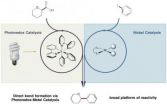(Press-News.org) OMAHA, Neb. – Researchers from the University of Nebraska at Omaha (UNO), the University of Nebraska-Lincoln (UNL) and Rice University have released a study that shows hormone levels can affect voter turnout.
As witnessed by recent voter turnout in primary elections, participation in U.S. national elections is low, relative to other western democracies. In fact, voter turnout in biennial national elections ranges includes only 40 to 60 percent of eligible voters.
The study, published June 22 in Physiology and Behavior, reports that while participation in electoral politics is affected by a host of social and demographic variables, there are also biological factors that may play a role, as well. Specifically, the paper points to low levels of the stress hormone cortisol as a strong predictor of actual voting behavior, determined via voting records maintained by the Secretary of State.
A link to the study can be found here: http://www.sciencedirect.com/science/article/pii/S0031938414002595
"Politics and political participation is an inherently stressful activity," explained the paper's lead author, Jeff French, Varner Professor of Psychology and Biology and director of UNO's neuroscience program. "It would logically follow that those individuals with low thresholds for stress might avoid engaging in that activity and our study confirmed that hypothesis."
Additional authors on the paper are Adam Guck and Andrew K. Birnie from UNO's Department of Psychology; Kevin B. Smith and John R. Hibbing from UNL's Department of Political Science; and John R. Alford from the Department of Political Science at Rice University.
The study is part of a larger body of research exploring connections between biology and political orientation, led by Smith and Hibbing. Previous studies have involved twins, eye-tracking equipment and skin conductance in their efforts to identify physical and genetic links to political beliefs.
"It's one more piece of solid evidence that there are biological markers for political attitudes and behavior," said Smith. "It's long been known that cortisol levels are associated with your willingness to interact socially – that's something fairly well established in the research literature. The big contribution here is that nobody really looked at politics and voting behaviors before."
"This research shows that cortisol is related to a willingness to participate in politics," he said.
To reach their conclusion, researchers collected the saliva of over 100 participants who identified themselves as highly conservative, highly liberal or disinterested in politics altogether and analyzed the levels of cortisol found.
Cortisol was measured in saliva collected from the participants before and during activities designed to raise and lower stress. These data were then compared against the participants' earlier responses regarding involvement in political activities (voting and nonvoting) and religious participation.
"Not only did the study show, expectedly, that high-stress activities led to higher levels of cortisol production, but that political participation was significantly correlated with low baseline levels of cortisol," French explained. "Participation in another group-oriented activity, specifically religious participation, was not as strongly associated with cortisol levels. Involvement in nonvoting political activities, such as volunteering for a campaign, financial political contributions, or correspondence with elected officials, was not predicted by levels of stress hormones."
According to the study, the only other factor that was predictive of voting behavior was age; older adults were likely to have voted more often than younger adults. Research from other groups has also pointed to education, income, and race as important predictors of voting behavior.
In explaining why elevated cortisol could be linked with lower rates of participation in elections, French cited previous experiments in which high levels of afternoon cortisol are linked to major depressive disorder, social withdrawal, separation anxiety and enhanced memory for fearful stimuli.
"High afternoon cortisol is reflective of a variety of social, cognitive, and emotional processes, and may also influence a trait as complex as voting behavior," French suggested.
"The key takeaway from this research, I believe, is that while social scientists have spent decades trying to predict voting behavior based on demographic information, there is much to be learned from looking at biological differences as well," he said. "Many factors influence the decision to participate in the most important political activity in our democracy, and our study demonstrates that stress physiology is an important biological factor in this decision. Our experiment helps to more fully explain why some people engage in electoral politics and others do not."
INFORMATION:
UNO contacts:
Jeffrey French, psychology professor, (402) 554-2558 or jfrench@unomaha.edu
UNO, Charley Reed, UNO media relations coordinator, 402.554.2129 or unonews@unomaha.edu.
UNL contacts:
John Hibbing, Foundation Regents University Professor of political science, University of Nebraska-Lincoln, 402.472.3220 or jhibbing1@unl.edu
Kevin B. Smith, professor, Political Science Department chair, University of Nebraska-Lincoln, 402.472.0779 or ksmith1@unl.edu
Hormones affect voting behavior, Nebraska researchers find
Study part of ongoing research into the biology of political belief
2014-06-24
ELSE PRESS RELEASES FROM THIS DATE:
A collaboration of minds and metal
2014-06-24
This past January, Derek Ahneman, a graduate student in the lab of Abigail Doyle, a Princeton University associate professor of chemistry, began work on an ambitious new project: he proposed the merger of two areas of research to enable a powerful reaction that neither could broadly achieve on its own.
One field, which is the Doyle research group's domain, was nickel catalysis, wherein nickel squeezes in and out of chemical bonds to bring molecules together. The other field was photoredox catalysis, which uses light to initiate a series of unique bond-breaking and bond-making ...
Researchers publish one of the longest longitudinal studies of cognition in MS
2014-06-24
Researchers at Kessler Foundation and the Cleveland Clinic have published one of the longest longitudinal studies of cognition in multiple sclerosis (MS). The article, "Cognitive impairment in multiple sclerosis: An 18-year follow-up study," (DOI: 10.1016/j.msard.2014.03.004) was epublished by Multiple Sclerosis and Related Disorders on April 13, 2014. Results provide insight into the natural evolution of cognitive changes over time, an important consideration for researchers and clinicians. Authors are Lauren B. Strober, PhD, of Kessler Foundation and Stephen M. Rao, ...
3-D printer for the world's largest delta?
2014-06-24
Boulder, Colo., USA - Three main rivers -- the Ganges, Brahmaputra, and Meghna -- meet in the Bengal basin to form the world's largest delta system, which serves as a gateway between the Himalayan mountains and the vast, deep-ocean Bengal Fan. This GSA BULLETIN paper by Stephen Goodbred and colleagues presents a new understanding of how this mega-delta, the Ganges-Brahmaputra-Meghna delta, came together over the past 10,000 years.
To determine the delta's construction during the Holocene, Goodbred and colleagues followed geochemical fingerprints to trace the paths and ...
NOAA GOES-R satellite black wing ready for flight
2014-06-24
The solar array that will provide power to NOAA's GOES-R satellite has been tested, approved and shipped to a facility where it will be incorporated on the spacecraft. The five sections of the solar array come together as one to resemble a giant black wing.
On May 13, 2014, the GOES-R satellite solar array panels were successful deployed in a Lockheed Martin clean room in Sunnyvale, California. The completed solar array was then delivered to Lockheed Martin's facility near Denver.
"The GOES-R solar array generates more than 4,000 watts of power, twice as much as that ...
Combo tumor imaging can distinguish malignant & benign breast tumors, help avoid biopsies
2014-06-24
PHILADELPHIA — Imaging breast tumors using four approaches together can better distinguish malignant breast tumors from those that are benign, compared with imaging using fewer approaches, and this may help avoid repeat breast biopsies, according to a study published in Clinical Cancer Research, a journal of the American Association for Cancer Research.
"By assessing many functional processes involved in cancer development, a multiparameter PET-MRI of the breast allows for a better differentiation of benign and malignant breast tumors than currently used DCE-MRI alone. ...
What millennials want
2014-06-24
Millennials, the generation after Generation X, born in the 1980s and 1990s, form their own demographic group, with their own unique tastes. According to a June 23rd panel at the 2014 Institute of Food Technologists (IFT) Annual Meeting & Food Expo® in New Orleans, industry must keep up with Millennials high-speed, digital-age expectations, if they're going to gain and keep them as customers.
"Millennials are food savvy and tech savvy," said Heidi Curry, Senior Manager Baker, Global Research and Development with Dunkin' Brands. "In addition, they're socially and environmentally ...
BMI measurement may be missing 25 percent of children who could be considered obese
2014-06-24
ROCHESTER, Minn. — Physicians using body mass index (BMI) to diagnose children as obese may be missing 25 percent of kids who have excess body fat despite a normal BMI, which can be a serious concern for long-term health, according to a Mayo Clinic study published online today in Pediatric Obesity.
The researchers found that BMI has high specificity in identifying pediatric obesity, meaning BMI accurately identifies children who are obese, but has a moderate sensitivity, meaning the BMI tool misses children who actually should be considered obese, according to the percent ...
Study suggests prayer can build unity in diverse organizations
2014-06-24
WASHINGTON, DC, June 24, 2014 — As the United States grows more diverse than ever, organizations from Fortune 500 companies to political parties are scrambling to keep pace. But in doing so, they face the challenge of uniting people from very different backgrounds in a single purpose.
A new study led by a University of Connecticut sociologist suggests that if they want to succeed, they could learn a lot from how an unlikely practice — prayer — is used in one set of diverse organizations.
Specifically, the study finds that interfaith group prayer serves as a "bridging ...
UF part of research team that finds equine influenza virus in camels
2014-06-24
GAINESVILLE, Fla. --- University of Florida researchers have found evidence that an influenza A virus can jump from horses to camels – and humans could be next.
The One Health Center of Excellence for Research and Training in UF's Emerging Pathogens Institute, in collaboration with U.S. and Mongolian institutions, has identified the first known case of an equine influenza virus in camels. Their findings will be published in the December issue of Emerging Infectious Diseases, but an ahead of print version of the report is available here:
http://wwwnc.cdc.gov/eid/article/20/12/14-0435_article
"Over ...
Prior drug use is the greatest predictor of ecstasy use US high school seniors
2014-06-24
Ecstasy, also known by its chemical abbreviation MDMA, is an illicit drug that is commonly taken at nightclubs and dance parties. Ecstasy's street names include: "Molly" (U.S.), "Mandy" (U.K.), "E," and "X." Although not limited to nightlife scenes, ecstasy is popular at dance parties, as it tends to enhance the party experience (e.g., perceptions of lights and music, nightlife socialization).
A study just published in the journal Substance Use & Misuse by researchers affiliated with New York University's Center for Drug Use and HIV Research (CDUHR), examined a national ...
LAST 30 PRESS RELEASES:
Making lighter work of calculating fluid and heat flow
Normalizing blood sugar can halve heart attack risk
Lowering blood sugar cuts heart attack risk in people with prediabetes
Study links genetic variants to risk of blinding eye disease in premature infants
Non-opioid ‘pain sponge’ therapy halts cartilage degeneration and relieves chronic pain
AI can pick up cultural values by mimicking how kids learn
China’s ecological redlines offer fast track to 30 x 30 global conservation goal
Invisible indoor threats: emerging household contaminants and their growing risks to human health
Adding antibody treatment to chemo boosts outcomes for children with rare cancer
Germline pathogenic variants among women without a history of breast cancer
Tanning beds triple melanoma risk, potentially causing broad DNA damage
Unique bond identified as key to viral infection speed
Indoor tanning makes youthful skin much older on a genetic level
Mouse model sheds new light on the causes and potential solutions to human GI problems linked to muscular dystrophy
The Journal of Nuclear Medicine ahead-of-print tip sheet: December 12, 2025
Smarter tools for peering into the microscopic world
Applications open for funding to conduct research in the Kinsey Institute archives
Global measure underestimates the severity of food insecurity
Child survivors of critical illness are missing out on timely follow up care
Risk-based vs annual breast cancer screening / the WISDOM randomized clinical trial
University of Toronto launches Electric Vehicle Innovation Ontario to accelerate advanced EV technologies and build Canada’s innovation advantage
Early relapse predicts poor outcomes in aggressive blood cancer
American College of Lifestyle Medicine applauds two CMS models aligned with lifestyle medicine practice and reimbursement
Clinical trial finds cannabis use not a barrier to quitting nicotine vaping
Supplemental nutrition assistance program policies and food insecurity
Switching immune cells to “night mode” could limit damage after a heart attack, study suggests
URI-based Global RIghts Project report spotlights continued troubling trends in worldwide inhumane treatment
Neutrophils are less aggressive at night, explaining why nighttime heart attacks cause less damage than daytime events
Menopausal hormone therapy may not pose breast cancer risk for women with BRCA mutations
Mobile health tool may improve quality of life for adolescent and young adult breast cancer survivors
[Press-News.org] Hormones affect voting behavior, Nebraska researchers findStudy part of ongoing research into the biology of political belief


